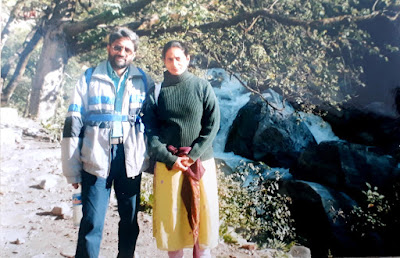 |
| Maggie and I on the way to Hemkund |
Trekking in the Garhwal Himalayas is both fun and
adventure. Thanks to the school in Delhi where I taught for a considerable
period of my life, I got opportunities to climb many a peak in the Himalayas
along with groups of young students. The best was the Hemkund trek.
Hemkund is a glacial lake that lies
about 15,000 feet (4572 metres) above sea level in the Himalayas. It’s a Sikh
pilgrimage centre dedicated to the tenth Guru, Gobind Singh (1666-1708). There
is a gurudwara on the bank of the lake. It is a two-day trek for ordinary folk
who are not professional trekkers in the mountains. You climb about
three-fourth of the total distance on day one. The trek starts from Joshimath,
the place that was in news two years ago because of the catastrophic floods and
landslides that wreaked unprecedented havoc in the mountains.
Joshimath itself is at an altitude of
6150 feet (1875 metres). Our bus carried us up to Joshimath from where we
started the trek early in the morning. You keep climbing. And climbing. The whole
day. With a backpack that carries the most essential things including your
lunch and drinking water.
Joshimath was nothing more than a
nondescript hill town in those days. It was twenty years ago that we undertook
this adventure along with a fairly large group of students from the seniormost
section. I don’t know how Joshimath would look like today. It must have lost
all the pristine charm it possessed in those days when we visited it. A lot of
buildings came up there later. Too much development which the fragile ecosystem
of the Himalayas could not endure.
The Himalayas are the youngest
mountain ranges in the world. Please recall your history lesson about how
Gondwana shifted from the south pole a few million years ago to hit the
northern continent forming the mountain ranges that we call the Himalayas
today. These mountains seem to be yet to stabilise. They are highly prone to
erosion even now, millions of years after their formation.
The cloudbursts of Feb 2021 wreaked untold havoc in Joshimath and nearby areas. Let me reproduce an image from Down to Earth to give you a picture of the damage caused by the rains then.
It was not just the rains. A glacier
had broken off along with its bedrock at around 5600 m above sea level from the
Ronti mountain peak, causing flood and landslides in the Rishiganga and
Dhauliganga rivers. The rivers changed their paths. Hundreds of houses were
washed away in the swirling waters. Development extracts too heavy prices
sometimes.
Twenty years ago, so much development
hadn’t reached the mountains. There were rains in those days too. In fact, it
was raining the whole afternoon of our trek. We all got drenched thoroughly. We
shivered beneath the plastic raincoats that we bought on the way from peddlers
who knew about the unpredictability of the rains in the mountains and hence did
brisk business as soon as it started raining. Our shoes squelched. But climb,
we did. When we reached the destination of day one, we were utterly fatigued.
But we knew there was one more day to go. The steepest ascent was just waiting.
The final stretch to Hemkund was really tough. But it is that arduousness which
makes a trek charming and unforgettable.
This was the first trek of our life, both
Maggie’s and mine. The first of such magnitude. Later, we climbed a few other
peaks in the Himalayas like Gaumukh and so on. But none of them has left as
many indelible imprints in our memories as Hemkund.
Today Joshimath, the base camp of
that classical trek, is sinking at the rate of 6.5 cm every year. Many
buildings have been abandoned. Many are in ruins. I don’t think I would like to
see the place now. Let my heart carry better memories. Of a little hill town
and its cool rivers of Alaknanda and Bhagirathi, the two rivers that unite at
Devaprayag forming the Ganga. I still remember watching that confluence, with
one river looking reddish with its muddy waters and the other crystal clear,
until they merge seamlessly into one and flow on and on quite as a symbol of all
the good and the bad that make up humanity. 
Maggie with a fellow trekker in front of the Badrinath Temple
PS.
Written for Indispire Edition 456: An unforgettable
journey #UnforgettableJourney

Hari Om
ReplyDeleteGood to hold onto those first impression memories, for changes are inevitable. Whether by nature or by mankind's encroachment. YAM xx
Let some memories linger...
DeleteLucky you went there at the time when it was pristine and could make pleasant memories,
ReplyDeleteI want to use this opportunity to Thank Dr Aziegbe a Powerful Spell Caster for what he has done for me and for Helping me to get my EX Back with his Love Spell, At First I Thought it's not Going to work until I have Faith in it and it Tell's me that it's Guarantee and Truly I have seen it. Thanks again PaPa I We Advice you People who need Love Spell to contract Dr Aziegbe a Powerful Spell Caster now contact him on WhatsApp +2349035465208 and also email: DRAZIEGBE1SPELLHOME@GMAIL.COM
ReplyDeletehttps://www.facebook.com/GRANDPA.AZIEGBE/
Sad what's happening to the environment everywhere. I especially loved that line of the two rivers merging. "symbol of all the good and the bad that make up humanity" So apt.
ReplyDeleteI was told that one of those rivers - I forget which - is always muddy and the other clear. Quite a sight it was then. Wonder whether that has changed now.
DeleteIt must be amazing to go to the Himalyas. I have only climbed Ben Nevis, Snowdon, Scaffel Pike and a few other smaller mountains.
ReplyDelete